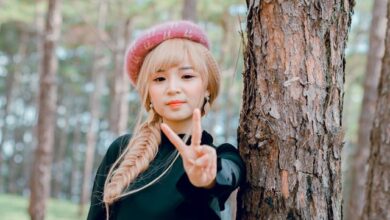Discover danielle idzi Journey: From Inspirational Speaker

In the vast world of creative expression, where talent is plentiful, and creativity is the king, a single name is getting noticed: Danielle Idzi. As a designer, artist, and visionary, Idzi is carving a niche for herself, enthralling viewers with her unique blend of creativity and authenticity. This article dives into Danielle Idzi’s personal, professional, and influence, highlighting her career and her impact on the world.
Table of contents
Who is Danielle Idzi?
danielle idzi is not just another name in the field of creativity; she represents a new wave of ideas and perspectives. Her background is full of artistic traditions, and the realm of imagination has always attracted Danielle. With a love of design and a keen eye for the finer things, Danielle has created an individual style that is a hit with many people.
Childhood and the Education of Danielle Idzi: A Path into Creativity
Danielle Idzi’s story starts in a tight, intimate community where imagination and creativity are part of her daily life. Her early life was shaped by a mixture of love and encouragement from her family and a deep-seated interest in design and Art, which established the basis for her upcoming endeavors. To fully comprehend the artist she is in the present, it is crucial to look into her early years and the educational experiences that helped shape her career.
1. A Childhood Immersed in Creativity
Danielle Idzi was born into an environment replete with creativity, and this influence was evident from a young age. As a child, she was raised in a household full of artistic expressions, from sculptures and paintings to handmade Art and crafts; different types of Art always surrounded Danielle. Her parents, awestruck by imagination, allowed her to explore various art forms and let her play with clay, paint, and pencils. They believed in encouraging their children’s imagination rather than imposing limitations on it.
2. The Influence of Family
Danielle’s family members had a significant influence on her creativity. Her mother, an amateur artist, would spend many evenings painting her canvas, and young Danielle would sit with her, glued to her. Her love for recording moments with Art led Danielle to get the paintbrush at a young age. In these moments of quiet observation, she came to appreciate the connection between an artist and their work. It is the determination, the emotion, and the ability to make something worthwhile.
Formal Education: A Foundation in Fine Arts
Formal education in fine arts provides a solid basis for future artists. It gives them the skills, knowledge, and context needed to succeed in a highly competitive and creative environment. The journey of a professional artist typically begins with formal education, which covers diverse disciplines like sculpture, painting, photography, graphic design, and many more.
1. Skill Development
Fundamentally, an education formalized in the fine arts provides students with fundamental technical knowledge. The students will learn the nuances of their chosen fields through traditional media, such as oil painting or clay modeling, or more contemporary techniques, such as digital Art or mixed media art. Professional instructors help students master fundamental skills that encourage experimentation and creativity. For instance, a person seeking an education in fine arts typically begins with classes focusing on composition and drawing.
2. Exposure to Diverse Mediums
One of the most impressive aspects of formal training in fine arts is the opportunity it offers to a wide range of artistic media. Students can discover sculpture, painting, printmaking and photography, digital Art, and installation art, among other things. This is essential in helping students identify their strengths and passions. Students can broaden their artistic horizons and find their voice through experimenting with various mediums. For instance, a person initially focused on painting could discover inspiration in the digital or sculpture worlds. This can lead to a multi-disciplinary approach that enhances their work.
3. Critical Thinking and Conceptual Development
The formal education in the fine arts extends beyond just skills development in technical areas. It also encourages conceptual thinking and critical thinking. Students are challenged to consider the significance of their work and the cultural contexts within the contexts in which they work. Through discussion, critiques, and studies, students are taught to evaluate their choices in Art and communicate their ideas energetically. Critiques play an essential role during this learning process. Students expose their work to their instructors and peers and receive constructive feedback, pushing them to improve their skills and strategies.
4. The Role of Faculty and Mentorship
The faculty of fine arts programs usually includes talented scholars and artists who bring abundant experience and expertise to the course. Their advice is crucial in guiding students’ artistic experiences. The instructors not only instruct the technical knowledge but also provide ideas on how to navigate the art industry, which includes the development of portfolios, exhibition techniques, and strategies for networking. Mentorship is an essential element of education in fine arts. A lot of programs stress the importance of developing relationships with faculty members who can favor personalized assistance and guidance.
5. Community and Collaboration
Formal education in the fine arts creates a sense of belonging among students, creating a space where creativity and collaboration thrive. Students frequently collaborate on projects, share resources, and grant assistance during times of difficulty. This kind of collaborative spirit helps one acquire interpersonal skills that are crucial to succeeding in the art field. Exhibitions and group projects allow students to work together on their creative projects. Collaboration encourages pupils to pool their talents and share their knowledge, which results in innovative projects that reflect a shared vision.
8. Arte Impact of Technology
Technology integration in art education has altered art practice in the last few years. Software and digital tools are now essential to contemporary artists, creating a creative expression with new ideas. Formal education in fine arts usually includes courses that focus on graphic design, digital Art, and media production. Students are taught how to use various software programs, including Adobe Creative Suite and 3D modeling programs.
9. Challenges and Criticisms
Although formal education in the fine arts can bring many benefits, it also has challenges and criticisms. One of the biggest concerns is the cost of tuition and the associated costs that could be an obstacle for many aspiring artists. Certain people may be discouraged from attending formal school and instead pursue self-directed studies or other options. In addition, critics claim that traditional fine arts schools might favor specific movements or styles over others, limiting creativity and innovation.
Digital Art is breaking boundaries with digital Art.
Art is the current world of innovation. Digital Art has become an exciting medium that goes beyond the limits of traditional Art. Artis contemporary art form is changing how artists create, communicate, share, and interact with their audiences. Thanks to the advancement of technology, digital Art has become an effective instrument that expands the possibilities of artistic expression, making Art accessible to everyone and available to a larger audience.
- The Evolution of Digital Art
Digital art Art has advanced a lot since its beginnings at the end of the 20th century. It began with basic computer graphics and primitive software, but technological advances have allowed artists to play with sophisticated ways and techniques.
- Collaboration and Community
Digital art communities thrive on cooperation and creativity. Artists can interact with one another via online forums, social media, and collaborative projects. The sense of community creates an environment in which artists can learn from each other, exchange ideas, and encourage one another.
- The Impact of Technology
Technology continues to be the driving force behind the advancement of Art. Art is digital. The rise in the virtual world (VR) and augmented reality (AR) has brought new ways of expressing Art. Artists can create immersive and engaging experiences to draw viewers in previously thought impossible ways.
- Challenges and Considerations
Despite the many benefits, the rapid growth of digital Art has risks. Sharing artwork online has raised questions about copyright infringement as well as plagiarism. Artists must deal with the complex world regarding intellectual property, a technological age where their work may easily be replicated and shared without permission.
The Future of Danielle Idzi: A Vision of Impact and Innovation
Danielle Idzi, a name associated with perseverance, imagination, and pioneering efforts, has earned an enviable reputation across many sectors that range from technology to advocacy. As we move into the 21st century, Danielle Idzi’s future is bright. This story explores the possibilities for her in the future, exploring the areas of potential growth, her leadership roles, and the impression she is likely to have on the next generation.
1. A Leader in Innovation
With her experience in advanced fields, she can lead the next wave of innovation. The fast pace of technological advancement, particularly in artificial information, data sciences, and green technology, provides numerous opportunities for individuals like her to shape the future.
2. Championing Sustainability
The worldwide shift towards sustainability is among the most significant issues of our time. Danielle Idzi has already shown interest in sustainable practices, and this topic will likely become the main focus of her next ventures. While businesses and governments work to meet their climate targets and reduce carbon footprint, The demand for green technology continues to grow.
3. Social Advocacy
Although Danielle Idzi is known for her work in technology and sustainability, her future will likely include much social activism. As a woman who believes in equality of opportunity for everyone, she’s already shown her dedication to diverse causes, and this is likely to remain the case shortly.
4. Lifelong Learning
In light of her desire for continuous learning, she may focus on creating platforms that support this process, especially for people who must upgrade their knowledge or reskill in a constantly changing job market. These platforms can use artificial intelligence to tailor learning experiences so that learners can study at their own pace and in ways that fit their needs.
5. Entrepreneurial Ventures
The next venture she is launching could tackle global challenges like poverty, clean water access, and affordable healthcare. Utilizing her knowledge of technology and innovation, Danielle could develop scalable solutions that increase living standards for the most marginalized populations.
6. Global Influence
What’s in store for Danielle Idzi is open to more than just a single industry or region. Her impact is international. In the years to come, she will push forward in sustainability, technology, and social and environmental advocacy. Her influence will expand beyond the national borders.
7. The Future of Danielle Idzi
Danielle is working on several exciting projects, including exhibitions exploring the interplay between technology and Art. Artese exhibits seek to challenge the traditional definitions of Art. Art encourages viewers to interact with the work of Danielle in new ways.
8. Advocacy and Philanthropy
Alongside her artistic activities, Danielle is passionate about using her platform to promote social good. She is a vocal advocate for mental health awareness, firmly believing Art is an effective healing method. By collaborating with mental health organizations, she hopes to increase awareness and the money to aid people suffering.
Conclusion
danielle idzi is a well-known name in the field of creativity. Her path, marked by passion, ingenuity, and a steadfast commitment to integrity, inspires artists worldwide. In her quest to challenge boundaries and redefine art expression, it is evident that Danielle Idzi is here to stay, and her influence on the art world is only beginning.




